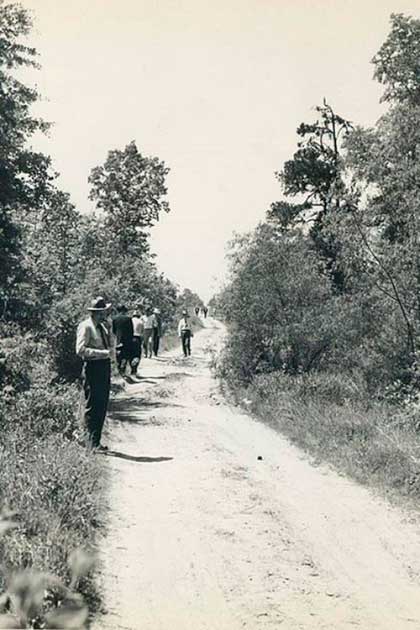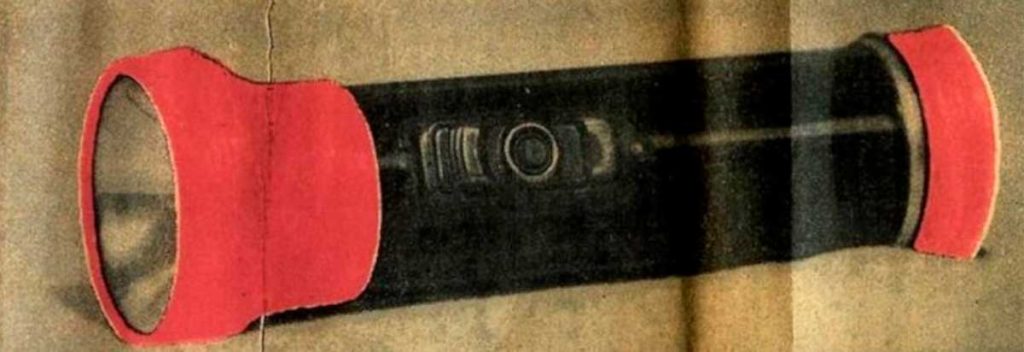There is something about an unsolved serial killer case that is both fascinating and frightening. Who was the killer? How did they get away with it? Is the murderer still alive and living in the town they tortured?
And, in one instance, how is a series of murders still unsolved after over 400 people were arrested and questioned as well as an investigation led by the FBI and Texas Rangers? When it comes to the Texarkana Moonlight Murders, these questions have remained unanswered since 1946. Will we ever discover the identity of the vicious Phantom Killer, who committed the Texarkana Moonlight Murders?
The Phantom of Texarkana
Texarkana is a city located along the border between the states of Texas and Arkansas in the United States, and is the name given to the surrounding area where the cultures of the two states blend together. The Texarkana Moonlight Murders occurred in Miller County, Arkansas, and Bowie County, Texas, for ten weeks between February 22 to May 3, 1946.
Eight people were attacked in total, and five of the victims were killed, leading to an investigation full of mistakes. Texarkana saw its share of violence, but these attacks shook the residents of Texarkana to their very core.
The first attack took place on the evening of Friday, February 22, 1946. A young couple, returning from a date to the movies, parked their cars in a popular lovers’ lane. Jimmy Hollis (25), and his date Mary Jeanne Larey (19), were approached by a strange man wearing a mask who shone a flashlight into the car at the pair. The man had a gun and demanded the two get out of their vehicle: the worst night of the pair’s life had just begun.

The masked man ordered Hollis to take off his pants, and as Hollis complied, he was struck in his head twice with a pistol knocking him unconscious. Larey would later tell police that the man hit Hollis so hard in his head that she believed he had been shot.
Horrifyingly, that sound Larey heard was Hollis’s skull fracturing. In a panic, she gave the stranger Hollis’s wallet, thinking that the masked man was there to rob them. That was not the case, and the man told Larey to get up and run.
The terrified girl ran to a parked car she saw up the road only to find the car empty, and the man quickly caught her. He knocked her down and sexually assaulted her with the barrel of his gun, and took off into the night, leaving behind the seriously injured couple. Fortunately, Larey was able to run to a nearby house to phone the police.
The police questioned her, and she said the attacker was a black man wearing a white bag or pillowcase over his head with holes cut out for the eyes and mouth. When Hollis regained consciousness, he contradicted her however, saying the attacker was a white man.
The conflicting stories sounded suspicious to the police, and when they considered how brutal the attack was, they assumed that Larey was lying and that she knew her attacker but said he was black to cover for the mystery man. It is possible that the police didn’t believe the girl because of her gender and figured she was embarrassed about the sexual assault with an object and lied.
The truth? The couple were traumatized and both had sustained head injuries. With that in mind, it is easy to see how they could have identified two men of different races when questioned later. Larey was so traumatized and upset that the police thought she was lying that she intended to move away from the Texarkana area.
The Second Attack
A month later on March 24th, a motorist spotted a car with two occupants parked in a lovers lane near US Highway 67 West and thought the couple in the car had slept there overnight. When the good Samaritan got closer to the car, he noticed they weren’t sleeping but were dead.

Police discovered that the man, Richard L. Griffin (29), had been shot twice in the car, and his girlfriend, Polly Ann Moore (17), was found shot in the backseat. Outside the car, the police found a blanket covered in blood and determined Moore had been killed on the blanket and then placed in the backseat of the vehicle.
Unlike the first attack, some evidence was found at the scene. A single .32 bullet casing had been left behind. The Texas Rangers and FBI analyzed the bullet and determined it was likely fired from a .32 Colt automatic pistol.
Strangely, the two victims were laid to rest before a pathologist could examine them, which was not standard protocol for police investigations. Some rumors around the time stated that Moore was not sexually assaulted, but other rumors said that she had been sexually assaulted. To this day, the truth about why the two were not autopsied and if Moore was a victim of sexual assault before her death remains unknown.
The Third Attack
By now the killer was clearly quickening to his task. Three weeks later in the early hours of April 14, 1946, Paul Martin (17) had picked his girlfriend Betty Jo Booker (15) up from a Veterans of Foreign Wars (VFW) Club, where she was a member of the evening’s musical entertainment.
Booker’s mom grew concerned when her daughter didn’t stop by the house to drop off her saxophone before spending time with her boyfriend. Her mother called the couple’s friends, but nobody had seen them. Police were called and a search was started and Martin’s body was soon discovered just off the side of a road. He had been shot four times: once through his nose, once in the back of the neck, once in the right hand, and once through the ribs.
Booker’s body was discovered almost 2 miles (3.2km) away from her boyfriend. She was found behind a tree with two gunshot wounds: once in the face and again through her chest. Martin’s car was found an additional 3 miles (4.8km) from Booker’s remains with the keys in the ignition.
The police could not determine who was murdered first. Like the previous murder, a bullet casing indicated that a .32 Colt automatic pistol was the murder weapon.
The Fourth Attack
The final attack of the Phantom Killer occurred on May 3, 1946, in the evening, and was very different to the previous attacks. Virgil Starks (37) was shot twice in the back of his head through a window while he read the newspaper. When his wife Katie Starks (36) heard glass breaking, she rushed to see what happened.

When she discovered her husband’s corpse, she ran to phone the police and came face to face with the killer. She was shot twice in her face, again through the same window, but managed to escape to her neighbor’s home across the street and was able to tell the neighbor her husband was dead before she lost consciousness.
Katie Starks survived her injuries and fully recovered. Still, when police questioned her after emergency surgery, she couldn’t tell investigators who attacked her and her husband because they never saw who shot them outside their home. All that was left behind at the scene was a black and red flashlight that nobody could identify.
The Phantom
In an attempt to solve the Texarkana Moonlight Murders, the police brought over 400 suspects in for questioning, but they were all cleared. The leading investigator, Texas Ranger Manuel Trazazas Gonzaullas, realized the attacks took place every three weeks and attempted to set a trap for the Phantom Killer.
Two undercover officers with mannequins posed as teenagers parked in lovers’ lanes. But the police had no luck: the Phantom never struck again. Residents in Texarkana began buying guns, guard dogs, and blinds for their windows. Curfews were set, and people locked their doors for the first time.
The killer was never identified, but two men were considered people of interest. The first possible Phantom of the Texarkana Moonlight Murders was 18-year-old H.B. Tennison. Tennison committed suicide in 1948.
He left behind a suicide note confessing being responsible for the Martin/Booker, and Starks murders. Tennison was in the same school band as Booker, but the two weren’t friends. #However, a friend of Tennison’s came forward to the police, telling them his friend did not kill anyone. They were playing cards at home when they heard the news reporting on the Martin/Booker murders.

The second possible Phantom of the Texarkana Moonlight Murders was a notorious car thief named Youell Swinney (29). Police discovered that on the night of every attack, a car was reported stolen and later found abandoned by the thief.
Swinney’s wife was seen driving a stolen car, and the husband and wife were arrested. Swinney’s wife confessed that her husband was the killer, but her story was inconsistent, changing details each time she was subject to questioning.
She did mention a location where some of Martin and Booker’s belongings were left by Swinney, but other than her confession, and there was nothing solid to tie Swinney to the Moonlight Murders. His wife was determined to be unreliable as a witness and could not testify against her husband in any trial.
He was sentenced to prison for his habitual grand-theft auto charges, where he would die almost 50 years later in 1994. Many found it suspicious that Swinney and his wife got married in the days before they were arrested. Did Swinney use marriage to keep the only person who could send him to the electric chair silent?
To this day, the Phantom Killer responsible for the Texarkana Moonlight Murders has never been identified. The murders have become part of the morbid history of the area. Each year around Halloween, the 1976 film The Town That Dreaded Sundown (based on the Texarkana Moonlight Murders) is shown in a local park as the finale of the annual “Movies in the Park” event hosted by the Texarkana Department of Parks and Recreation.
For a terrifying series of unsolved murders that sent residents of Texarkana deep into the throws of terror, the tradition of free public screenings of a film based on the murders is definitely just as creepy as a serial killer who disappeared into the night, never to be seen again.
Top Image: Despite a huge manhunt for the killer, the Texarkana moonlight Murders remain unsolved to this day. Source: Alex Corv / Adobe Stock.
By Lauren Dillon